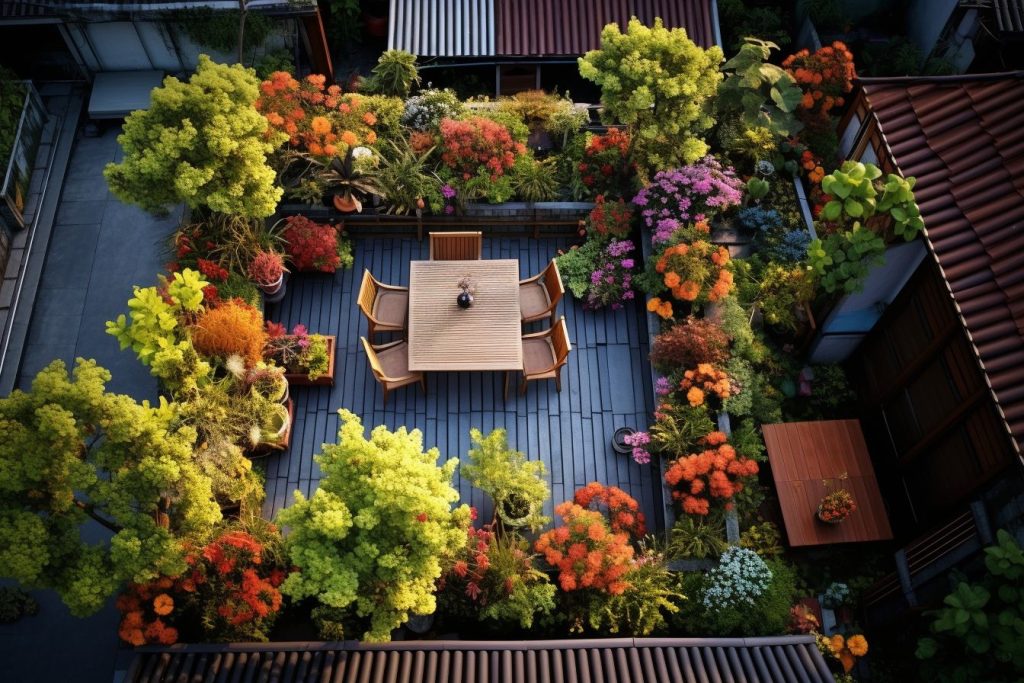Are you considering starting a roof garden but don’t know where to begin? You’re not alone – many city dwellers are looking to transform their unused rooftops into verdant retreats, as these gardens enhance living spaces and contribute to environmental sustainability.
Our comprehensive guide brims with tips and tricks for designing, installing, and maintaining your rooftop green oasis. Let’s get started – a rooftop is just waiting to bloom!
Key Takeaways
- Designing a roof garden requires strategic planning to keep the space open and inviting, allowing natural light to thrive and reducing energy consumption.
- Creating privacy in a rooftop garden can be achieved through techniques like green walls or fences, providing shade and seclusion.
- Grow tall plants and trees for added depth and privacy, but make sure they are suitable for rooftop conditions and consider structural requirements.
- Raised beds are a great way to maximise limited space, offering versatility and bountiful gardens teeming with homegrown vegetables.
- Choosing the right plants is crucial for a successful roof garden, considering factors like water management, sun exposure, wind resistance, disease prevention, pest control, and efficient use of limited space.
- Incorporating furniture adds functionality and comfort to your roof garden while enhancing its overall appeal.
- The focal point creates an attractive centrepiece in your rooftop oasis that complements its surroundings without overpowering them.
- Outdoor lighting enhances the beauty of your roof garden and makes it functional after sunset by highlighting specific areas or features.
- To install a green roof successfully, you must consider factors such as waterproofing, drainage system, slope, and selection of vegetation that can thrive in shallow soils with limited nutrients.
- Maintaining a healthy roof garden involves selecting appropriate plants, implementing proper watering, fertilising schedules, regular trimming, monitoring plant health, and providing adequate drainage.
Tips for Designing a Roof Garden
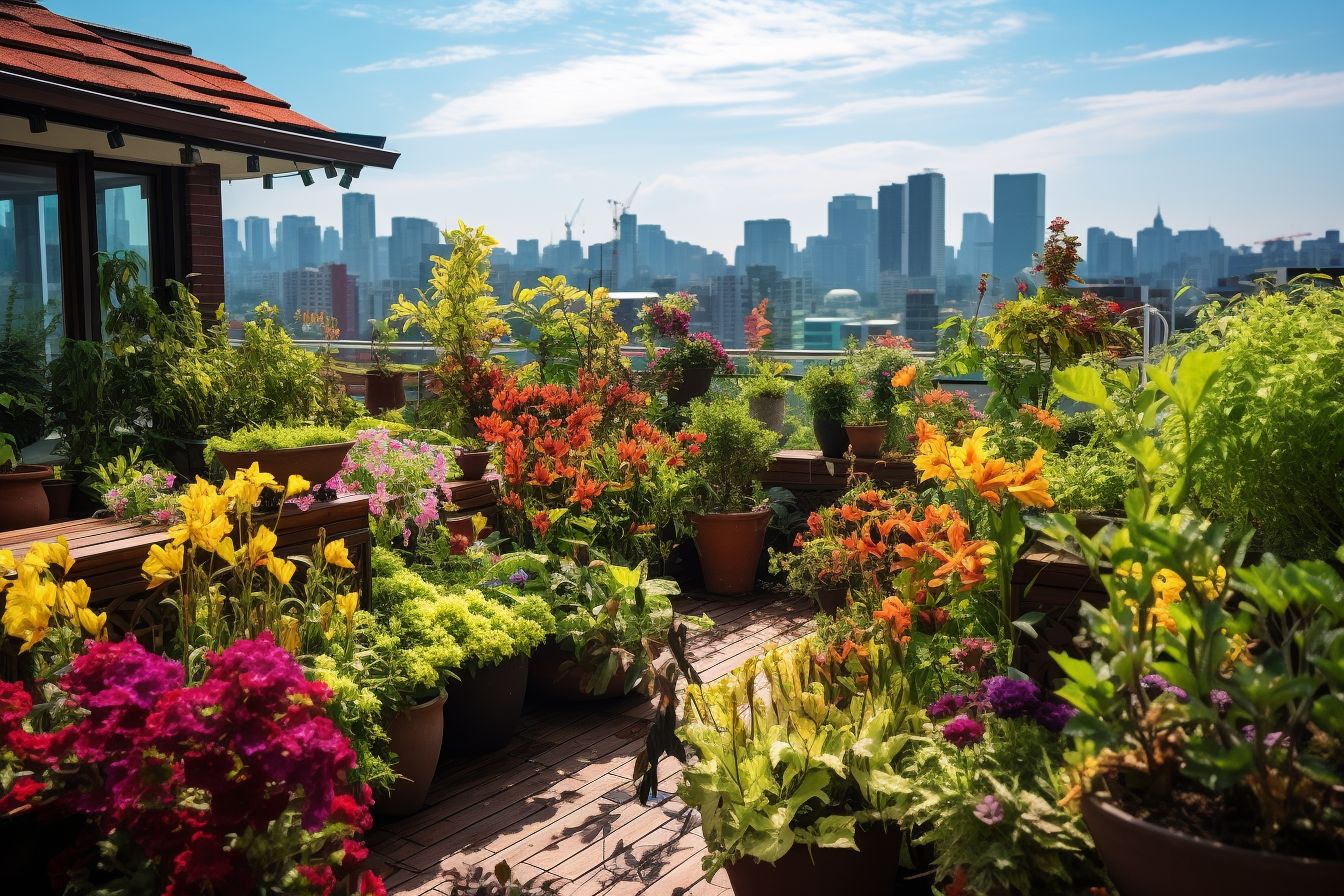
Keep the space open to create an inviting and spacious rooftop garden.
Keep the space open.
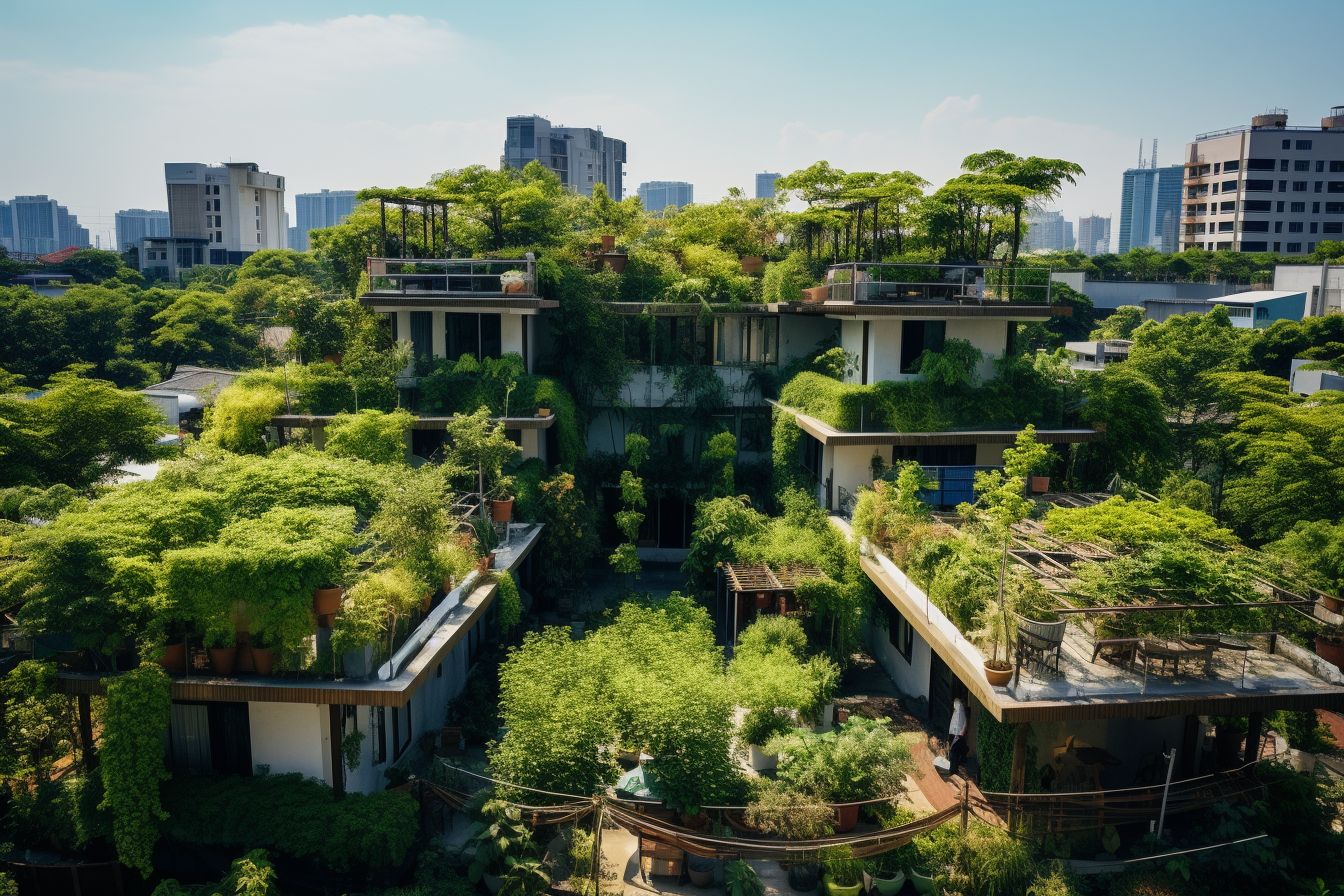
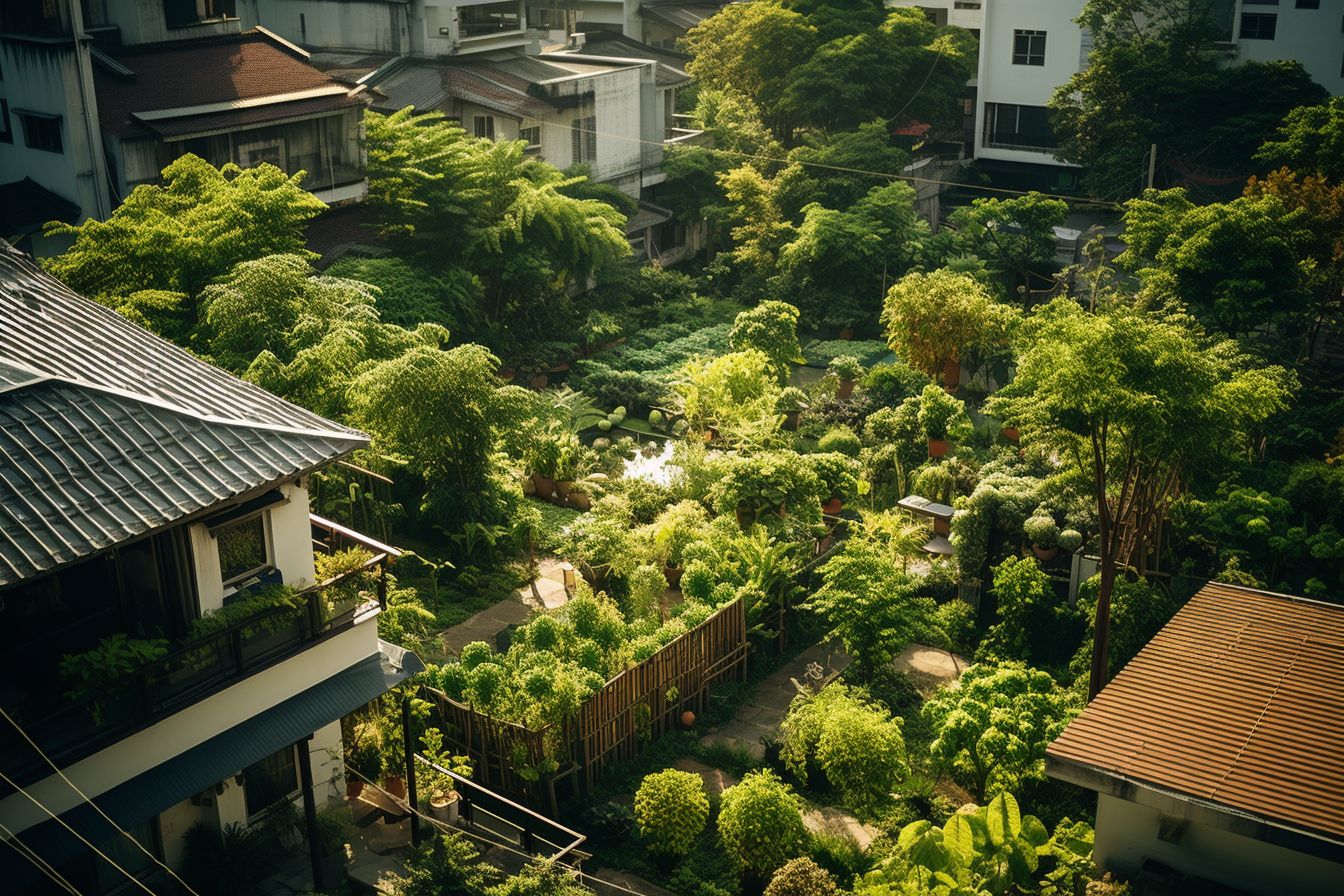
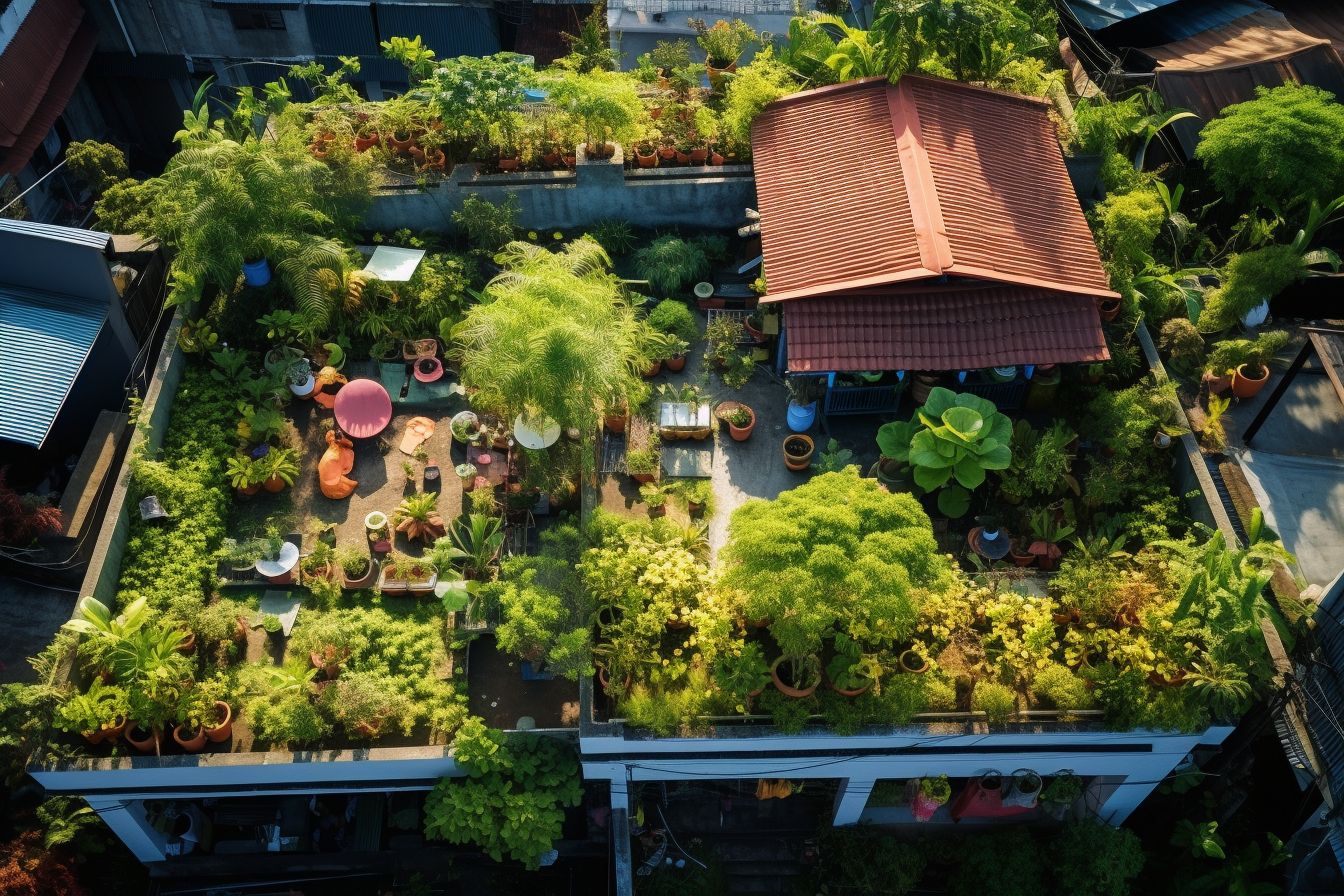
Designing your roof garden requires strategic planning to keep the space open and free-flowing. An open layout invites natural light, making your rooftop an ideal place for plants to grow and thrive.
This design choice also transforms your roof into a relaxing retreat where you can enjoy panoramic views of the skyline. A spacious rooftop garden significantly reduces energy consumption by providing insulation, thus contributing to eco-friendly landscaping practices.
When planting trees or tall plants, be sure their positions don’t encumber the openness of the space, as this can enhance biodiversity without compromising on aesthetics or practicality in urban gardening scenarios.
Create privacy
Creating privacy in a rooftop garden can transform it into a private and tranquil oasis. Several techniques exist to block sight lines, ensuring you have your peaceful retreat right in your home.
Starting with green walls or vertical gardens provides dual benefits: they offer shade from sunlight and add an extra layer of privacy.
Investing in a privacy screen or fence is another effective way to enhance seclusion. Also, consider incorporating tall plants or trees into the design for their beauty and obstructing views.
Additionally, garden enclosures can help conceal aspects that may interfere with the space’s aesthetic appeal, such as poorly maintained neighbouring areas or utility fixtures on roofs nearby.
Each concealment technique plays its part in delivering a serene rooftop landscaping experience looking at nothing but the sky.
Grow tall plants and trees.
Tall plants and trees infuse a sense of depth and height into your roof garden. Select species appropriate for rooftop conditions to ensure they grow well. Structural requirements become critical in this scenario, considering the possible impact on load-bearing capacity and access.
Evaluating these factors helps keep structural integrity intact while allowing you to enjoy the privacy that tall flora offers. Maintaining these additions requires regular plant care for optimal growth and longevity, providing your outdoor living space with natural beauty.
Furthermore, considering potential retrofitting or engineering needs ensures the sustainability of your roof garden design featuring tall plants and trees.
Use raised beds
Raised beds revolutionise rooftop farming, offering a personal touch and versatility that traditional planting methods can’t match. They provide root vegetables with at least 10 inches of soil for healthy growth.
Craft your raised beds using lightweight materials such as plastic, fibreglass or foam planting containers to ensure the stability of your rooftop garden structure. A key advantage is their capacity to transform limited spaces into bountiful gardens with homegrown vegetables.
To yield this tranquil oasis in urban settings, meticulous planning ensures each raised bed contributes to an aesthetically pleasing layout.
Choose plants carefully
Selecting the right plants forms the core of a successful roof garden. Consider water management, sun, and wind exposure before deciding on your verdant companions. Drought-tolerant species serve well in sunny, windy settings typical of rooftop environments.
These hardy varieties survive harsh conditions and provide insulation benefits by absorbing sunlight that would otherwise heat up your building.
Equally important is disease prevention and pest control in preserving the health of your aerial oasis. Routinely inspect plants for signs of infestation or disease; taking prompt action can prevent widespread damage.
Finally, consider garden size while making plant selections. A large roof space allows for various sizes and types, whereas smaller areas may require precise selection to maintain an open feel.
Correct landscaping techniques optimise limited space, turning it into a green haven amidst urban surroundings.
Incorporate furniture
Outdoor furnishings do more than just spruce up your rooftop garden. They enhance user comfort while adding functionality to the space. Be it loungers for relaxation, tables for a meal beneath the stars or seating areas designed for socialising, furniture can transform your roof into an outdoor living area.
Selecting weather-resistant and durable pieces is crucial. This ensures that your outdoor setting withstands different weather conditions, offering longevity. Also, consider how you place your furniture within the garden layout because good placement can result in seamless flow through the space, creating a cosy atmosphere that invites guests to relax and socialise amidst nature’s beauty.
Outdoor loungers are quite popular among homeowners who like their comfort, whereas others might prefer functional yet chic outdoor tables that come in handy during get-togethers on warm summer evenings.
Add a focal point.
In a well-designed roof garden, you’ll find a central feature that immediately catches the eye. This eye-catching element is known as the design focal point, and it draws your attention to a particular area or highlights a standout element.
You can create this point of interest using various items like sculptures, unique plant arrangements or even distinctive furniture pieces. The positioning of such an attractive focus needs strategic planning to enhance your rooftop space’s beauty effectively.
Always consider size and scale when choosing your main attraction; you want it to complement its surroundings in your roof garden setting, not overpower.
Install outdoor lighting
Installing outdoor lighting is a crucial step in designing a roof garden. Not only does it enhance the beauty and ambience of the space, but it also makes the rooftop garden more functional after sunset.
By strategically placing lights, you can highlight specific features or areas of the garden, such as pathways or seating areas. This adds to the overall aesthetics and ensures these spaces are safely navigable in low-light conditions.
With well-designed outdoor lighting, you can create a beautiful and inviting atmosphere for your rooftop garden, allowing you to enjoy its charms day and night.
How to Install a Green Roof
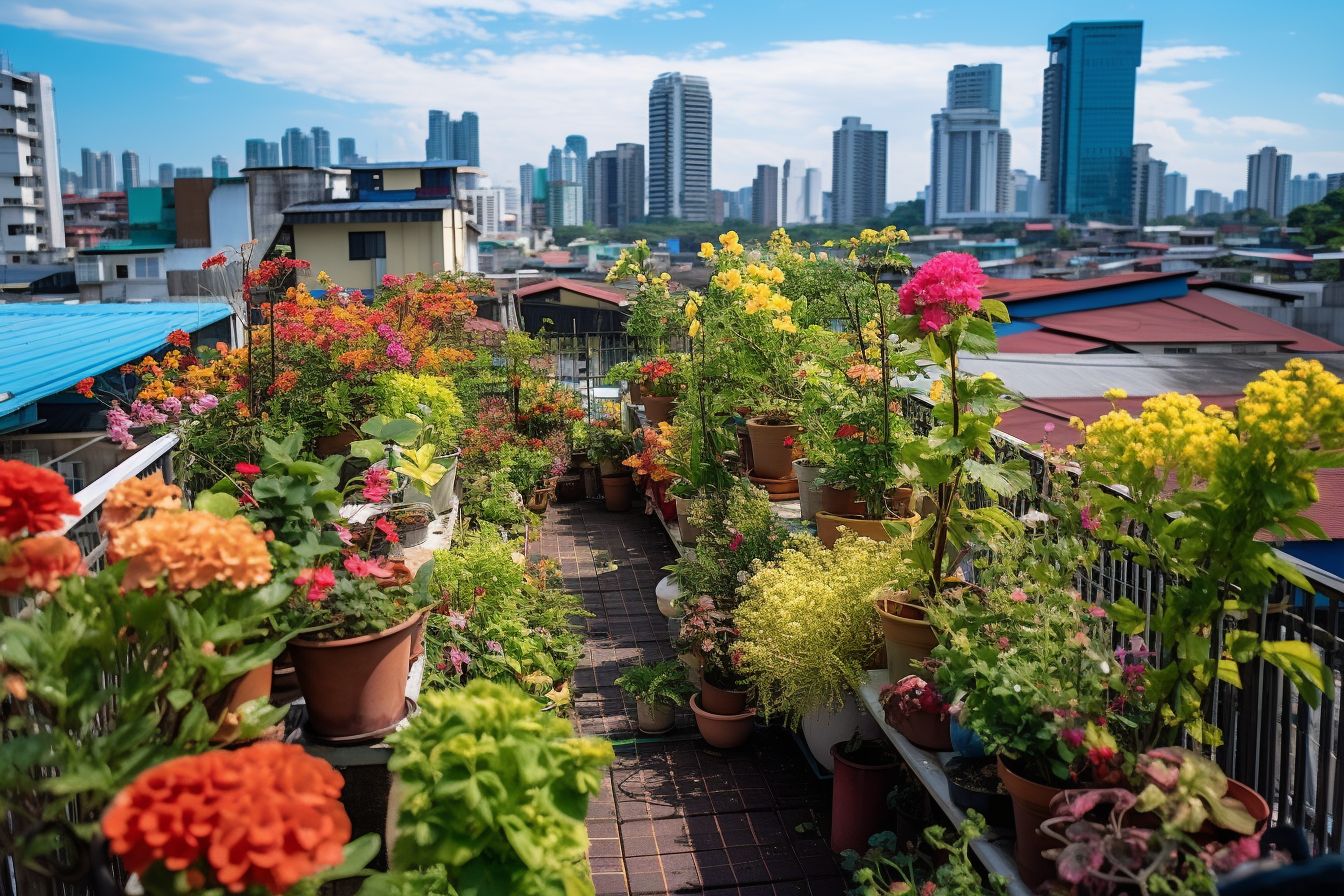
Installing a green roof can enhance the view of your home, reduce energy costs, and provide eco-friendly benefits. To install a green roof, you must consider several factors, such as roofing materials, waterproofing, drainage systems, slope, insulation, vegetation, water retention, and energy efficiency. Here are the steps to follow:
- Prepping the roof: Ensure your roof has the proper pitch to shed water towards gutters. This will prevent water from pooling on your green roof.
- Waterproofing: Apply a waterproof membrane or layer to protect your roof from leaks and moisture damage.
- Drainage system: Install a drainage system below the soil layer to direct excess water away from your roof.
- Slope: Create a slight slope on your green roof to encourage water runoff and prevent pooling.
- Insulation: Add insulation layers on the waterproofing membrane for better energy efficiency and temperature regulation.
- Vegetation: Choose plants suitable for rooftop environments and can thrive in shallow soils with limited nutrients.
- Water retention: Use lightweight engineered soil that retains moisture and is well-draining. This will help conserve water and prevent overwatering.
- Energy efficiency: Consider adding solar panels or using reflective materials on your green roof to increase energy efficiency.
Tricks for Maintaining a Roof Garden
Choose plants that thrive in rooftop environments, implement a watering and fertilising schedule, regularly monitor and trim plants, protect against pests and diseases, and provide adequate drainage.
Select plants that thrive in rooftop environments.
Choose well-suited plants for rooftop gardens to ensure their survival and growth. Rooftops can create unique microclimates, so it’s important to consider the specific conditions of your rooftop when selecting plants.
Opt for low-maintenance options that are drought-tolerant and wind-resistant. These plants will require minimal care while still flourishing in the rooftop environment. Additionally, choose species that can withstand exposure and provide shade without depending on tall trees, as these may not be suitable for rooftops.
You can create a thriving and beautiful garden space by carefully selecting plants that thrive in rooftop environments.
Implement a watering and fertilising schedule.
To keep your roof garden healthy and thriving, it is important to implement a regular watering and fertilising schedule. Here are some essential tips to remember:
- Water your plants in the early morning or late afternoon to minimise evaporation.
- Use a hose with a nozzle attachment for efficient watering.
- Monitor the moisture level of the soil regularly to avoid overwatering or underwatering.
- Apply organic fertiliser according to the specific needs of each plant.
- Avoid using chemical fertilisers that can harm the environment.
- Consider using slow-release fertilisers for a more consistent nutrient supply.
- Adjust your watering and fertilising schedule based on seasonal changes and weather conditions.
Regularly monitor and trim plants.
Monitoring and trimming plants is crucial for maintaining a healthy and thriving roof garden. Here are some important tips to keep in mind:
- Inspect your plants regularly for signs of pests, diseases, or other issues affecting their growth.
- Using sharp and clean gardening tools, trim dead or damaged leaves, branches, or flowers.
- Prune overgrown plants to maintain their shape and size, promoting better airflow and sunlight penetration.
- Remove any weeds competing with your desired plants for nutrients and water.
- Monitor the growth of your plants and adjust their positioning if necessary to ensure they have enough space to thrive.
- Regularly fertilise your plants according to their specific needs to promote healthy growth and blooming.
- Water your plants adequately, ensuring they receive enough moisture without becoming waterlogged.
Protect against pests and diseases.
Effective pest control measures are crucial for maintaining a healthy and thriving roof garden. One approach is to practice integrated pest management, which combines various strategies to minimise pest activity on vegetated roofs.
Regular inspections are essential in identifying signs of infestation, such as chewed-up plants, burrows, nests, or droppings. Additionally, removing decaying vegetation helps avoid attracting pests.
By taking proactive and preventive measures to eliminate conditions that attract pests, rooftop gardens can create a less appealing environment for these unwanted visitors.
Managing pests effectively ensures the long-term vitality of your roof garden and promotes a flourishing ecosystem.
Green roofs also need protection against diseases that could harm plant life. Preventive measures should be taken to avoid disease outbreaks among the vegetation in rooftop gardens.
Provide adequate drainage
Proper water management is essential for maintaining a healthy and thriving roof garden. Adequate drainage is crucial in preventing water runoff and sustaining plant growth.
The roof garden can retain soil moisture and ensure sustainable water usage by mimicking natural ecosystems. An efficient drainage system helps prevent rainwater from entering the sewer system, allowing it to nurture the plants and stay within the soil.
This not only supports the health of your rooftop garden but also contributes to green infrastructure and effective stormwater management.
Benefits of Roof Gardens
Roof gardens maximise limited space, reduce energy consumption and greenhouse gas emissions, improve air quality and reduce noise pollution, as well as enhance aesthetics and create a peaceful retreat.
Maximises limited space
Rooftop gardens are an excellent way to maximise limited space in urban areas. Utilising the otherwise unused roof space can create additional or reclaimed usable areas for gardening and outdoor recreation.
This is especially beneficial in densely populated cities where land is scarce. With a rooftop garden, you can enjoy the benefits of greenery and fresh air without sacrificing precious square footage on the ground level.
Whether growing vegetables, creating a peaceful retreat, or simply adding aesthetic appeal to your building, rooftop gardens provide a sustainable solution for maximising limited space while enhancing the overall environment.
Reduces energy consumption and greenhouse gas emissions
Roof gardens offer numerous benefits, including reducing energy consumption and greenhouse gas emissions. By creating an additional layer of insulation on the roof, these green spaces help to regulate temperatures inside buildings, reducing the need for artificial cooling and heating systems.
As a result, less electricity is consumed, and fewer fossil fuels are burned to generate power, decreasing greenhouse gas emissions. With rooftop gardens promoting energy efficiency and sustainable living, they significantly mitigate climate change by minimising our carbon footprint.
It improves air quality and reduces noise pollution
Rooftop gardens offer numerous benefits, one of which is improving air quality. By releasing oxygen and absorbing carbon dioxide, these green spaces help to purify the surrounding air.
In urban areas with high pollution levels, rooftop gardens can play a crucial role in reducing air pollution and fighting climate change. The plants in these gardens also capture airborne particulates, further contributing to cleaner air.
Additionally, rooftop gardens have the added advantage of reducing noise pollution. Thick vegetation roofs act as sound barriers and can significantly decrease the noise that penetrates buildings, creating a more peaceful environment for those living or working nearby.
In summary, rooftop gardens provide aesthetic appeal, maximise limited space, and bring about environmental benefits such as improved air quality and reduced noise pollution.
It enhances aesthetics and creates a peaceful retreat
A roof garden not only enhances the aesthetics of a building but also creates a peaceful retreat. Adding greenery and natural elements beautifies the exterior and adds value to the structure.
The lush vegetation and comfortable seating areas promote serenity and create a calm getaway amid urban living. This tranquil oasis supports emotional and psychological wellness by providing a soothing space for relaxation and rejuvenation.
Additionally, it improves a property’s overall look and worth, making it more desirable for potential buyers or tenants. With its combination of visual appeal and tranquillity, a roof garden creates a peaceful and serene environment that elevates the overall ambience of any rooftop setting.
Conclusion
In conclusion, designing and maintaining a rooftop garden can be a rewarding and sustainable way to maximise limited space while enhancing the aesthetic appeal of your building. You can create a peaceful retreat in the city’s heart by following these tips and tricks, such as creating privacy, choosing appropriate plants, and incorporating furniture and lighting.
Embrace the benefits of urban gardening with a beautiful roof garden that adds value to your property and helps reduce energy consumption and improves air quality.
FAQs
1. How do I start a roof garden?
To start a roof garden, ensure the structure can support the weight of plants and soil, choose suitable containers or raised beds, select appropriate plants for your climate and sunlight, and provide proper drainage.
2. Can I grow vegetables in a roof garden?
Yes, you can grow vegetables in a roof garden. Choose vegetable varieties well-suited to container gardening and ensure they receive enough sunlight, water, and nutrients for healthy growth.
3. How often should I water my roof garden?
The frequency of watering your roof garden will depend on various factors such as plant types, weather conditions, and soil moisture levels. Generally, it is recommended to check the moisture level regularly and water when the top inch of soil feels dry.
4. Are there any maintenance tasks involved with a roof garden?
Maintaining a roof garden involves regular upkeep tasks such as pruning plants, removing weeds, fertilising as needed, monitoring pest infestations or diseases, and checking for proper drainage to avoid water accumulation.

